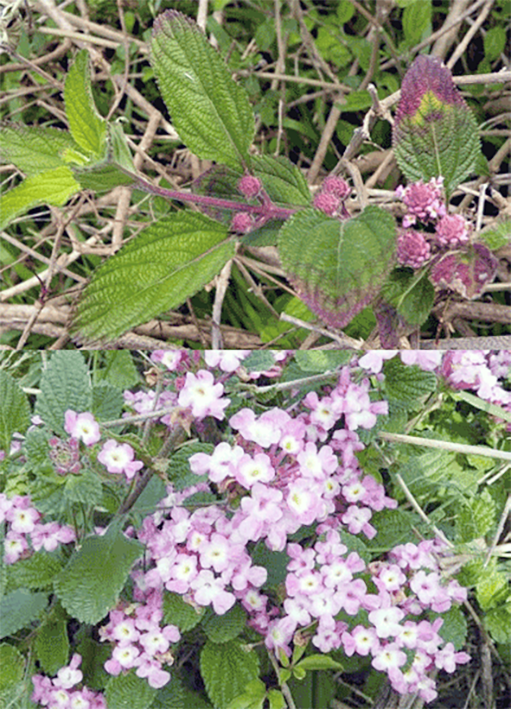 Bushy Lippia
Lippia
alba, plants
showing leaves and
flowers..
Bushy Lippia
Lippia
alba, plants
showing leaves and
flowers..
Welcome to the summary page for FabulousFusionFood's Herb guide to Bushy Lippia along with all the Bushy Lippia containing recipes presented on this site, with 0 recipes in total.
e This is a continuation of an entire series of pages that will, I hope, allow my visitors to better navigate this site. As well as displaying recipes by name, country and region of origin I am now planning a whole series of pages where recipes can be located by meal type and main ingredient. This page gives a listing of all the Cornish recipes added to this site.
These recipes, all contain Bushy Lippia as a major herb flavouring.
Bushy Lippia, Lippia alba, (also known as Bushy Matgrass, Hierba Negra, Juanilama, Liquorice lippia, Melissa, Oaxaca lemon verbena, Pitonia, Salvia Sija) is a flowering plant in the Verbenaceae (verbena family). It is a native to Mexico, the Caribbean, Central America, South America and Texas in the United States. The plant itself is a multi-branched shrub, reaching a height of 1.5m. Its leaves measure 1 to 3cm in length and between 0.9 to 2cm in width and are opposite and arranged in clusters of threes. The leaves show variable forms with a pointed apex, cuneiform or decumbent basis and serrated or crenated borders. When crushed they produce the typical lemon smell that characterizes this species. The flowers are typically white or pink, with light blue to purple corollas and are borne on spices some 2cm long. The fruit is composed of two indehiscent nuclei, each containing one brown seed.
On crushing, the predominant scent from the leaves is that of lemon (from limolene), but with overtones of camphor and liquorice (hence its alternate name of Liquorice lippia). The essential oil composition is unique to each plant, but may include piperitone, geranial, neral, caryophyllene, camphor, eucalyptol, limonene, carvone, germacrene, α-guaiene, β-ocimene, linalool, or myrcene. The sweet taste is caused by a sesquiterpene compound called hernandulcin, which was discovered in 1985 and named for Francisco Hernández, the Spanish physician who first described the plant in the sixteenth century.
Most typically the plant is grown as a garden ornament and for its fragrant flowers. But in South America it is grown for its healing properties. However, in the Oaxaca region of Mexico it's used as an herb, most specifically to flavour meat dishes. The leaves can also be used in any recipe calling for lemon verbena.
e This is a continuation of an entire series of pages that will, I hope, allow my visitors to better navigate this site. As well as displaying recipes by name, country and region of origin I am now planning a whole series of pages where recipes can be located by meal type and main ingredient. This page gives a listing of all the Cornish recipes added to this site.
These recipes, all contain Bushy Lippia as a major herb flavouring.
Bushy Lippia, Lippia alba, (also known as Bushy Matgrass, Hierba Negra, Juanilama, Liquorice lippia, Melissa, Oaxaca lemon verbena, Pitonia, Salvia Sija) is a flowering plant in the Verbenaceae (verbena family). It is a native to Mexico, the Caribbean, Central America, South America and Texas in the United States. The plant itself is a multi-branched shrub, reaching a height of 1.5m. Its leaves measure 1 to 3cm in length and between 0.9 to 2cm in width and are opposite and arranged in clusters of threes. The leaves show variable forms with a pointed apex, cuneiform or decumbent basis and serrated or crenated borders. When crushed they produce the typical lemon smell that characterizes this species. The flowers are typically white or pink, with light blue to purple corollas and are borne on spices some 2cm long. The fruit is composed of two indehiscent nuclei, each containing one brown seed.
On crushing, the predominant scent from the leaves is that of lemon (from limolene), but with overtones of camphor and liquorice (hence its alternate name of Liquorice lippia). The essential oil composition is unique to each plant, but may include piperitone, geranial, neral, caryophyllene, camphor, eucalyptol, limonene, carvone, germacrene, α-guaiene, β-ocimene, linalool, or myrcene. The sweet taste is caused by a sesquiterpene compound called hernandulcin, which was discovered in 1985 and named for Francisco Hernández, the Spanish physician who first described the plant in the sixteenth century.
Most typically the plant is grown as a garden ornament and for its fragrant flowers. But in South America it is grown for its healing properties. However, in the Oaxaca region of Mexico it's used as an herb, most specifically to flavour meat dishes. The leaves can also be used in any recipe calling for lemon verbena.
The alphabetical list of all Bushy Lippia recipes on this site follows, (limited to 100 recipes per page). There are 0 recipes in total:
Page 1 of 1
Page 1 of 1